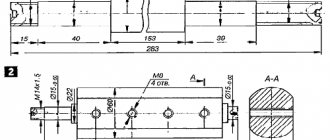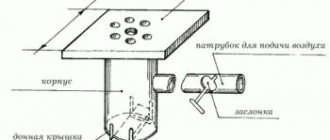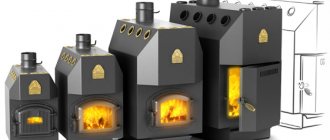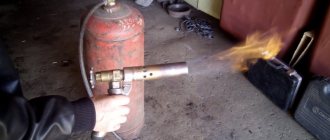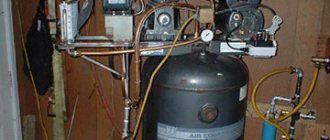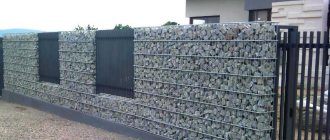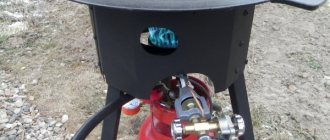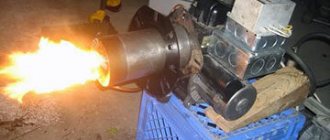The central element of a gas boiler should be considered the burner. All other components are built around it.
A lot depends on how this unit is designed, and first of all, the efficiency of the boiler, so the owner of an autonomous heating system should have a good understanding of this issue.
Our material will serve as a good assistant in this important matter. At the same time, let's see how to make a gas burner for a boiler with your own hands.
Homemade gas burners
The main components in the manufacture of powerful gas burners are industrial valves. They may be new, but for a homemade device it is enough to use used ones if there is no gas leak. They are designed to work in tandem with a 50-liter propane gas cylinder, which has an angle valve and a reducer.
Burner with valve VK-74
The structure of this burner is shown in Fig. 1. The oxygen cylinder valve VK-74 is used as a basis. A fitting-handle machined on a lathe is installed at the outlet end, to the corrugated part of which the hose from the cylinder is connected. A cap with a prepared hole with a thread for the nozzle is screwed onto the part of the valve with a conical thread K3/4˝, with which it was connected to the gas cylinder. You can use a ready-made blowtorch or gas stove.
The nozzle is made from a piece of 1/4˝ steel pipe 100 mm long and welded to the cap on two pieces of ∅5 mm wire. A distance of 15 mm should be left between the cap and the nozzle to allow air to enter the combustion zone. The position of the nozzle is adjusted by bending the wire holders to achieve a central flame position.
Sequence of actions to ignite the burner:
- Open the cylinder valve;
- Place a lit match near the nozzle and slowly open the burner valve;
- Control gas ignition;
- Adjust the flame using the burner valve
A homemade gas burner of this design has one drawback associated with the location of the valve. The gas flow is directed in the opposite direction to the normal position. Stuffing box seals experience constant gas pressure (including when the valve is closed), so it is necessary to constantly monitor the tightness of the seals.
Burner converted from acetylene gas cutter
If you have an acetylene torch with a faulty oxygen supply valve, do not rush to throw it away. It is also suitable for making a burner (Fig. 2). The mixing chamber requires modifications, the contents of which must be removed to reduce weight. The oxygen barrel and valve will need to be removed. Solder the resulting hole with hard solder. Connect the hose coming from the gas cylinder reducer to a fitting with a left-hand thread M16 × 1.5.
Using a union nut, secure a homemade tip bent at 45° to the mixing chamber to make it more convenient to work with the burner. Screw a flange with a nozzle welded to it onto the thread of the tip.
One of the options for such a burner is to use a cap with an M22 × 1.5 thread. The design of the nozzle here is similar to the nozzle of the burner described above. The homemade gas burner is ready for use.
Gas mini burner
Mini gas burners are more suitable for working with small parts. The mini burner is based on a needle for inflating balls. It is necessary to make a cut in it, a little further than the middle of the needle. Some needles already have a similar hole, which significantly speeds up the work process. Next, you need to take the syringe needle and bend it about 45 degrees in the middle.
Mini gas burner design
It is best to sharpen the pointed end of a syringe needle so that it is straight. After this, it needs to be inserted into the ball needle so that one end comes out through the hole, and the other protrudes from the large needle by several mm. The resulting mini structure should be fixed using soldering. After this, droppers must be attached to the bases of the two needles. Clamps - dropper regulators need to be moved as close to the needles as possible. In the resulting burner they will act as gas and air supply regulators. They also need to be fastened together, and this is best done using a heat gun. All that remains is to connect a source of compressed gas to the finished device, the burner is ready for use. This homemade gas burner can heat objects up to 1000 degrees
You should work with it carefully, observing safety precautions
Opening the valve
Valve on a gas burner
The power of such a device can be controlled by closing or opening the valve. The highest temperature is concentrated in the green-blue part of the fire. To adjust the nozzle, you need to place a torch in the middle of it. To do this, the wire holders are slightly bent.
To create a working version of the burner, a tip is welded to its nozzle. Its angle of curvature is 45⸰.
The basis for manufacturing may be a steel valve (also from a cylinder). A plug with a hole for the nozzle is threaded onto its exiting section. It is taken from a blowtorch. The diameter of its nozzle is 0.8 mm. The required diameter of the burner nozzle is 3 cm. The length of the nozzle can be varied with nozzles. This is how the torch parameters are controlled. The valve becomes the regulator here.
What is a jet (nozzle)
Almost all gas stoves are equipped in such a way that they can operate on both natural gas and propane (from a replaceable cylinder). It should be taken into account that when switching to liquefied gas, it is necessary not only to replace the nozzles, but also to install a reducer, which is responsible for equalizing the pressure of the incoming fuel.
The reducer stabilizes the pressure of bottled gas, ensuring normal operation of the stove. It automatically maintains the pressure parameters necessary for the operation of the equipment and prevents backflow of the medium
A nozzle (nozzle) is a bolt with a hole in the head for supplying gas to the burner. After entering the burner, the gas is mixed with air, and the gas-air mixture is ignited.
The nozzle ensures that gas enters the burner in the required volume and at the appropriate pressure. Its size determines the volume of gas required for the normal combustion process
Depending on the fuel used, nozzles are of two types: for supplying blue fuel from the main pipeline and for supplying gas from a gas holder or cylinder.
Jets (nozzles) for natural gas in comparison with jets for liquefied fuel are characterized by:
- Shortened bolt body;
- Fewer threads;
- Increased hole diameter.
If the stove is not operating correctly, it is best to replace not just one jet, but the entire set at once, and when switching to bottled gas, this is generally a necessity.
Why and why is it necessary to change the jet?
Jets for different types of gas vary significantly, so when changing the type of gas-air mixture, replacing the nozzles is simply necessary
If you pay attention to the diameter of the hole, it becomes obvious that they are not the same. In this case, the diameter of the hole depends not only on the type of gas used, but also on the size of the burner itself
Some time after replacement, negative factors may appear indicating that the stove is not working properly. Don’t rush to change the jet right away; you may be able to limit yourself to cleaning it
Each of the gas stove burners differs in power and size, so for stable operation it is equipped with a separate nozzle.
The diameter of the outlet of each nozzle is calculated for a certain volume of gas supplied from the main line or gas tank
The more powerful the burner, the greater the volume of gas it requires to operate, therefore the diameter of the nozzle is required to be larger.
Choosing a nozzle for bottled gas
As already mentioned, the propane nozzle has a shortened body and a smaller outlet diameter. It is not recommended to try to reduce the hole yourself, since even fractions of millimeters are important here. By eye you can only improve the operation of the stove, but not achieve its ideal operation.
It is important to understand that standard jets simply do not exist. They are designed for each specific model
Modern kitchen stoves are equipped with a set of jets designed to operate on propane. Some models are even produced specifically for bottled gas.
A set of nozzles for a specific model can be purchased at a specialized gas equipment store or directly from a representative of the official supplier
Features of a homemade design
The main task that the future homemade device will perform is heating a room, tent, garage and other premises. When assembling it yourself, the appearance of the device and its decorative qualities fade into the background.
An important role will be played by the sufficiency of the amount of heat generated, the safety of operation and the ease of transportation of the device.
Lightweight, portable and easy-to-use designs made from gas burners cope well with the task of heating small spaces
For heating purposes, a variety of homemade gas structures are used. Making heaters from gas burners or gas stoves with your own hands is not difficult. For quick assembly, you will need a pre-prepared diagram, the material from which the heater will be made, and a variety of tools.
Often a homemade gas heater is taken on a camping trip outside the city or on a fishing trip, on trips, to various gatherings as a source of additional heat. In such cases, it will be enough to assemble the device, check its functionality, inspect it for leaks and proceed directly to heating.
Sometimes a homemade heater is planned to be used as an alternative heating source. For example, in a country house, in a barn, in a paddock, in a garage and in other premises in order to save money on utility bills and on the purchase of gas equipment.
Often the prototype for the manufacture of a mobile gas heater is gas infrared burners and factory-made tiles
In such cases, care must be taken to minimize heat loss within the heated room. This is done by insulating the external and internal walls, floor and ceiling of the structure. It is most effective to carry out simultaneous internal and external insulation procedures. Then the heat will last as long as possible, and gas consumption will be much reduced.
If it is not possible to carry out two types of insulation at the same time, then you need to insulate the building at least from the inside. It's more efficient. When carrying out the procedure, it is necessary to use a material suitable for thermal insulation, as well as fire-resistant materials and coatings.
Insulating the heated room significantly reduces heat loss. In such rooms, the heating device will not work in vain, and, therefore, the user will not spend extra money on buying gas
When using gas equipment, you must always observe safety precautions and adhere to the rules for installing equipment and insulating premises. If a heated building is finished with fireproof materials, then it will be fire resistant. This significantly reduces the risk of fire and unexpected fires.
It is best to place a homemade gas heater in the center of the heated room. In this case, the generated heat is not lost or absorbed by the walls, since there is no contact with them. Warm air will go up to the ceiling of the room. If you also install special reflectors on the ceilings, the effect of a thermal cap will be created in the room.
This positive phenomenon allows you to significantly save money on space heating using homemade gas structures. Warm air circulates throughout the space and does not leave it. It is worth knowing that the heat cap effect is created when the heater emits a sufficiently intense air flow.
The main quality that a home-made device should have is safety of operation. If there is a leak while using the heater, you must immediately stop the gas supply.
Based on the results of assembly, a homemade heating device should have the following parameters:
- safe and easy operation;
- economical consumption of energy resources, in this case gas;
- efficient and fast heating of rooms;
- quick start of the device, possibility of long-term operation;
- ease of assembly and ease of replacement of failed parts;
- possibility of transporting the device;
- sizes convenient for carrying, transportation and operation.
All of the above characteristics are quite difficult to fit into one design. However, some craftsmen manage to independently make a gas heater of sufficient power, convenient, easy to use, which serves the user for a long time.
The advantages of homemade gas heaters include:
- Economical work. Sometimes one full cylinder can be enough for 12 hours of continuous operation of the device. Of course, it all depends on the size of the cylinder.
- Ability to quickly turn on and off.
- Compact and light weight. Some homemade designs are convenient to take on hikes. They do not take up much space and weigh several kilograms. And the beneficial effect of their use is difficult to underestimate.
Among the disadvantages of homemade designs is the need to select a suitable cylinder or have an adapter. Therefore, you need to take care of purchasing additional cans in advance. Or be able to transfer gas from a large cylinder into a small tank.
The heat exchanger is an important structural part of the heater. It is a steel box with welded pipes passing through it. The heat exchanger is installed in a metal casing. A fan is also installed
Some self-made gas heaters cannot withstand severe subzero temperatures and will not start if the air temperature is below a certain level. Facing such a problem can overshadow a tourist trip. However, indoor temperatures usually do not drop to very low levels.
If the heater operates indoors, it is necessary to ensure the supply of fresh air. It is also important to consider that the level of carbon dioxide indoors increases. Air humidity decreases significantly.
Do not leave the device turned on unattended, or bring flammable objects near it. This may cause fire and ignition.
The operating efficiency of a self-constructed device is determined by its main characteristics.
Efficiency factor . This indicator is determined by the ratio of the energy that is used for heating to the energy that is spent to generate it. Gas heaters have different efficiency values.
Device safety. Often, on home-made structures, the installation of devices that ensure safe operation is neglected: valves, sensors that automatically turn off the burner.
The operation of this device is as follows. The burner heats the inner tubes. The air that comes in from outside is heated by the tubes and becomes hot at the exit. The exhaust pipe removes carbon dioxide from the room
Fuel consumption and area heated by the device. Depending on the size of the device, fuel consumption also changes. The larger the room, the larger the burner will be required.
Design of a homemade gas burner
- metal case;
- gearbox;
- nozzle;
- fuel supply regulator;
- head;
- a unit for securing a gas cylinder.
The metal case includes a special glass, with the help of which the mechanism eliminates the possibility of blowing out the flame. This also includes a metal or other handle that does not exceed 100 centimeters. A wooden holder and a gas hose are installed on top of the handle. Using a reducer and a tube with a valve, the gas supply level and its length are adjusted accordingly. The nozzle is used to ignite the fuel, in this case the latter is propane.
Operating principle of the Babington burner
A few words about the history of the invention. The considered method of burning heavy fractions of liquid fuel appeared relatively recently - in the middle of the last century. More precisely, inventor Robert S. Babington (RS Babington) patented his diesel burner in 1969. However, the patent has long expired and now its device is available to everyone interested.
Babington’s invention is fundamentally different in operating principle from traditional oil burners, where a mixture of air and fuel is injected by a nozzle under pressure:
- Exhaust or diesel is supplied from the tank by a low-capacity pump.
- Fuel drips onto the working surface - spherical or inclined. The fuel flows down along it, forming a thin film.
- In the center of this surface there is a hole of small diameter (no more than 0.3 mm), through which the compressor pumps compressed air.
- A Babington waste oil burner operates on the following principle: a stream of compressed air exiting through a small orifice under pressure tears off part of the oil film from the surface.
- As a result, we obtain a jet of air-fuel mixture, which, after ignition, forms a stable flame. It is sent to the firebox of a furnace or boiler, heating the walls of the chamber or the water jacket. The figure below shows the operation diagram of the burner device:
Since some of the fuel flows past the hole, a flow back into the tank is organized
. Here you can clearly see that the unburnt remains of used oil flow from the hemisphere into a special container, and from there back into the main tank. From it, the fuel is supplied for combustion under low pressure, and is preheated to liquefy it. As you can see, the design does not provide any filter elements.
Preheating waste oil or diesel fuel before burning it with a Babington burner is very important and here's why:
- The heated waste liquefies and forms a thinner film on the working surface, which is well atomized by the air flow. This promotes more efficient combustion.
- The smaller the droplets of liquid fuel suspended in the stream, the easier it is to ignite a boiler or Babington stove in manual/automatic mode.
Reference. Finding and buying a ready-made Babington burner in a factory version is unrealistic. Well-known manufacturers of oil and diesel units, for example, KROLL or EURONORD, do not produce them. There is only one way out - order a burner from a good craftsman or make it yourself.
Equipment setup
Floor-standing gas boilers with an atmospheric burner can be configured independently. Pressurized systems are regulated by an automatic control unit and do not require additional configuration.
Scheme of actions for setting up single-stage equipment:
- Install the device on the boiler.
- Connect to the gas pipe.
- Check for absolute tightness.
- Remove the burner housing.
- Using a pressure gauge, measure the gas pressure at the inlet.
- Connect to electricity. Make sure that the jumpers and phases are connected correctly.
- Place a gas analyzer in the chimney pipe.
- Start the device.
- Using a pressure gauge, take pressure readings at the outlet of the burner block. Pressure readings must correspond to the parameters indicated in the data sheet.
- Adjust the air flow using the air damper.
- The gas analyzer readings must also comply with all gas equipment installation standards.
Setting up gas equipment should be carried out by specialists. The simplest open-type boilers can be configured independently if you have certain skills and knowledge of the design of the burner unit. The efficiency of the boiler, its level of efficiency, and fuel consumption depend on the quality of the burner. It is possible to superficially determine that the equipment is malfunctioning by the changed burner flame.
A heating system where the main element is a gas stove is a common type of heating for private households and cottages. There are many things in favor of natural gas as a heat source: high efficiency, environmental friendliness, and the ability to make the heating process fully automated. The fuel itself is also the most inexpensive at present, unless, of course, you take into account wind energy and solar radiation. But these methods have not yet found wide demand due to the unaffordable price of the equipment.
The quality of gas heating depends on how efficiently the gas burner for the stove works.
Purpose and principle of operation
It does NOT matter in which country the tandoor was used, but all these ovens worked on the same principle. Firewood was placed in the lower part of the oven, the ceramic walls retained even heat for a long time, and many different dishes could be cooked inside the oven
When the firewood turns into coal, it is partially removed, and the rolled out dough is placed on the walls of the oven, which after a very short time turns into a fragrant flatbread. The meat is cooked either on skewers like shish kebab, or in ceramic dishes, which are placed on special brick stands installed at the bottom of the oven.
The main advantage of an Asian stove is its ability to maintain a high temperature for a long time with a small amount of fuel. In addition, the food is not fried, but baked inside the oven, retaining all its beneficial properties.
Since ancient times, stoves were buried or built directly in the ground, this allowed them to save building material. But these days, you can choose any type and size of oven, which will cook your favorite dishes many times faster.
Making a nozzle with your own hands
Before you start using a product made at home with your own hands, you need to go through the following procedures:
- The burner must undergo a quality check at the local Rostechnadzor office in accordance with the regulations established in the Federal Law on the Safety of Buildings and Structures dated December 30, 2009.
- After this check, it is necessary to obtain a certificate from Rostekhnadzor regarding the suitability of the burner for operation.
In order to start making the nozzle, you need the following materials:
- A valve that will serve to regulate the fuel supply of the device. To supply gas to the burner, you must use the valve installed on the gas source.
- Steel pipe. It is desirable that it have a thickness of up to 2 mm and a length of up to 100 mm.
- Steel cap for making a fuel dispenser. You can also use a jet from a blowtorch.
- Steel handle. It can be made from a regular fitting.
- Rubber for handle lining.
- Wire. It will be used for welding.
You will also need the following tools:
- Welding machine.
- Grinder for cutting parts.
For homemade production, an atmospheric nozzle is preferable due to the simplicity of its design. The procedure is as follows:
- First, screw the cap onto the valve. For example, if a standard VK-74 valve is used, then the cap has a conical thread.
- Then, by cutting the existing steel pipe with a grinder to the required size, the nozzle of the future nozzle is made - its basis.
- Next, the nozzle is welded to the cap using wire. In this case, the cap and nozzle should not touch.
- A piezoelectric element is installed, which is needed to activate the device.
After this, the product is ready for installation.
Attention! To install a system for supplying fuel to the stove from a central heating system, you need special equipment and experience working with gas systems
Furnace installation
When installing a finished unit in a furnace, take into account what materials it is made of:
The gas nozzle - the heart of the stove - must be of high quality and correctly installed. If this unit malfunctions, fuel-related problems may occur, which can lead to irreversible consequences.
The process of creating a burner yourself
A homemade version of the burner for gas boilers operating on solid fuel can be made based on a valve from a gas cylinder, more precisely an oxygen one. A homemade fitting must be inserted into its outlet pipe. It can then be attached to the gearbox. The connecting element becomes a rubber-fabric hose when manufactured independently.
The inlet pipe enters the cylinder itself during the manufacturing process. You need to put a cap on it. A hole is made in the cap for connecting a jet, which is taken from a gas stove or a blowtorch.
Using welding, a nozzle is attached to a homemade cap. The nozzle is a steel pipe element. Its length is 10 cm. Wall density is 2 mm.
The cap and the nozzle separate some space - 1.5 cm. Air is drawn in through it. For this reason, three thick wire elements are first attached to the cap in the same way. And a pipe-nozzle is mounted to them.
The methods for igniting this homemade product are as follows: opening a tap on the main gas network, or on a cylinder (it is needed when using a liquefied gas format).
The nozzle holds a fire source: a match, a lighter or a lit paper wick. Production is not difficult, at first glance.
Types of burners
According to their design and functional differences, burner devices are divided into:
By purpose:
- for high power industrial equipment
- for household equipment.
By type of fuel used:
- devices for natural gas;
- devices for liquefied gas;
- universal devices.
By adjusting the flame:
- single-stage – capable of operating on/off;
- two-stage (as a variation - models with smooth modulation) - operate at full power, when the desired temperature is reached, the flame is reduced by half;
- modulating - boilers with a modulating burner are characterized by smooth adjustment of the flame power.
According to the principle of operation:
- injection/atmospheric. They operate by supplying air from the room. They are installed respectively in open combustion chambers. Also used for old-style boiler models.
- fan/supercharged. They work in isolated combustion chambers. Combustion air is supplied by a fan. According to their design features, they are divided into: - vortex (round-shaped nozzle holes) - direct-flow (shape of a narrow slot with a round/rectangular cross-section).
- diffuse-kenetic. Air enters two simultaneously: one is mixed with gas fuel, the second is added directly to the chamber during combustion.
Is it worth designing a gas boiler yourself?
Let’s begin our analysis of options for making a gas boiler with our own hands with the fact that the fuel they process is classified as toxic and explosive substances. Gas is highly flammable. The slightest miscalculations in the design and implementation of homemade products can result in serious destruction, damage to health, and loss of property.
Therefore, we do not recommend developing a model of a gas boiler for people who do not have a technical education with a specialization in the design of gas equipment. Yes, often even experienced gas workers will not take on such a project.
The optimal solution is quite reasonably considered to be:
- Converting a solid fuel model into a gas boiler by installing a gas burner in the firebox;
- Improvement of an old but functional unit with a focus on use in a heating circuit. Supplementing the factory model with devices for heating and stimulating the movement of coolant;
- Manufacturing of a pyrolysis boiler - equipment that generates gaseous fuel as a result of processing solid fuel at the initial stage. At the secondary stage, the gas released during the combustion of wood is burned in an additional firebox.
If you still have a desire to thoroughly study the issue and invent a version of a homemade gas boiler for autonomous heating in a private house, get ready for a literal “walk through agony.” You will have to obtain permits and confirmation of the safety of the invention from a number of government supervisory authorities.
An independent craftsman will need:
- Check the boiler for compliance with safety requirements , and then obtain a confirming or refuting document.
- Obtain permits from GosTechNadzor, Fire Inspectorate of the Ministry of Emergency Situations and GorGaz.
- Apply for a patent and a certificate allowing one-time or continuous production.
This list, although not numerous, is quite impressive and can discourage any folk from inventing documents. However, it will not be able to quell the desire to modernize an existing unit by installing factory-assembled burner modules. The improvement easily combines operational safety with increased efficiency.
The most important working part in gas equipment is the burner. Installing it will turn any boiler into the type of coolant and hot water heater we require for sanitary purposes.
Depending on the method of supplying the combustion air required for combustion to the combustion chamber, burners are divided into two main groups:
- Atmospheric. They are installed in open combustion chambers of atmospheric boilers. In them, air is drawn freely from the room in which the boiler is located.
- Fan (also known as blower). Such models are equipped with closed combustion chambers into which air is forced in a forced manner and captured from the street. To remove flue gases, they require a coaxial chimney and a fan.
Blowing designs are too complex for home creativity. They are easier and more profitable to buy. After all, purchasing all the adjustment and safety devices for operating a fan burner can be more expensive than purchasing a module ready for installation.
It is also advisable to purchase an atmospheric burner, but you can make the simplest version with your own hands. Below we will consider how and from what it can be assembled.
Operating principle and differences of gas equipment
You cannot objectively judge the quality of the purchased injector. Do not disassemble the finished product in search of possible defects. So there is a chance to damage rather than check an expensive device.
By assembling each element of the burner yourself, you will receive not only pleasant satisfaction from the work done, but also savings. At the same time, the operation and repair of gas bath equipment will become safe and conscious.
The heating gas unit is a sauna stove body with a gas supply device located in it. Here are the main elements of the control mechanism with which the fuel supply is regulated.
The burner heats the air in the firebox. The thermal energy of the nozzle is transferred through the body to the tray with stones
A heating stove with a gas nozzle requires special attention to the chimney, which must be cleaned periodically.
The advantages of heating water and sauna stones with a gas burner include:
- Simplicity of the workflow. To heat up, just turn the valve and ignite the gas in the burner. In an hour, the steam room of the bathhouse will be sufficiently heated.
- Environmentally friendly. During operation of a gas device, harmful emissions during gas combustion have the smallest volume compared to other types of fuel.
- Ease of maintenance of the burner and the stove itself. There is no need to deal with soot from walls and remove waste, as with coal or firewood.
You can equip the oven with special sensors that are triggered at a critically low exhaust speed. In this case, the gas supply is automatically turned off.
Inexpensive fuel from a gasified stove allows you to not limit the number of bath procedures. Even with daily heating of the bathhouse, maintaining cleanliness becomes very easy
Such a disadvantage of a homemade burner, such as additional registration of technical permits, pays off due to high productivity. Using a gas injector will save 30% costs compared to solid fuels. Heating a sauna with gas is two times cheaper than using an electric boiler.
Features of use
Gas burners are unpretentious in maintenance. The main feature is annual cleaning. In this case, the procedure should only be carried out by highly qualified specialists, since this requires disassembling the boiler. Most often, burner cleaning is carried out by a service center.
Dirt can be easily removed using compressed air. It is important to set the appropriate pressure. The fact is that some modern parts may not withstand a flow of 10 atm.
To make the cleaning process faster and less frequently required, a special filter is installed on the gas supply. This is done by the master after submitting an application to the appropriate structure.
Well, despite the fact that a gas burner in a heating boiler seems like a very complex engineering unit, you can still make it yourself without any problems. To do this, you need to prepare all the necessary materials and have the skills to work with metal. In addition, you must have several units of special tools.
Modernization of heating equipment
Any home craftsman can install a homemade atmospheric gas burner for a sauna stove. So, without any special costs, a solid fuel boiler can be converted into a gas one.
Equipping an existing solid fuel stove in a sauna with a factory-made gas burner unit will require some adjustment. You will be faced with the need to modify the dimensions of both the burner and the combustion chamber of the wood-burning stove.
Converting a solid fuel sauna stove into a combined gas and wood stove is within your power, but it will require precision and some effort. Do not allow the flame to come into contact with the walls of the firebox
To heat the combustion chamber evenly, the burner should be positioned closer to the bottom of the stove and strictly in the center. It is unacceptable to place the source high and offset in any direction. In this case, the camera will not warm up completely. And the flame from the burner can touch metal parts or the heater of the sauna stove.
How to choose?
What you need to pay attention to when choosing a burner device for a boiler:
- productive power - noise level during operation (applies to supercharged models) - type of heating equipment for which the burner is purchased - type of fuel - pros and cons of this device - provide for possible malfunctions in the operation of the local gas supply line.
Taking these factors into account, you can choose the most suitable burner device for your boiler so that it operates as efficiently as possible without the burden of frequent preventative maintenance.
DIY instructions
Next, we will talk about several options for homemade propane burners that you can make with your own hands. In order to build a simple burner, you won’t need a lot of effort and skill, but creating the other two options will require you to work harder.
Option 1 - the simplest burner made from a piece of pipe
Building such a burner will require very little time and effort. But the process of creating a homemade product must be approached with all responsibility, because you will have to work with an explosive substance and any error in the design of the device can lead to dire consequences.
Using such a device, you can heat metal blanks for forging or warm them up before welding, and you can also repair bitumen roofing. The owner of a private house will definitely not find such a homemade product superfluous.
A properly made propane burner will last a long time. With its help you can perform many household tasks without using a number of expensive tools.
To make a homemade gas burner you will need the following tools and materials:
- two pieces of pipe of different diameters;
- union;
- gas hose;
- gearbox;
- propane tank;
- welding machine;
- Bulgarian.
Having prepared all the tools and materials, you can begin assembling the propane burner. But before that, we recommend that you familiarize yourself with the rules for safe work with an angle grinder.
As you can see, there is nothing complicated about assembling a gas burner yourself. Having studied the instructions and having the necessary set of tools and materials at hand, assembling the device will take no more than an hour.
Option 2 - powerful gas burner
We also suggest trying to assemble a more structurally complex, but also more powerful burner.
To build this option, you will need a little more tools and materials, but the result will not disappoint you.
Such a propane burner can be used, for example, for melting metal in a forge, for burning weeds in your own area, as well as for other purposes
So, to build a propane burner you will need to prepare the following materials:
- connecting couplings – 1/2” and 1/4”;
- threaded barrel – 1/2” and 1/8”;
- plug with internal thread – 1/8”;
- foot – 1/4”*1/8”;
- nipple – 1/2”;
- quick connector for low pressure gas equipment;
- propane supply regulator – 0.068-0.34 atmospheres;
- thread sealant;
- a metal sheet;
- self-tapping screws;
- drills – 6.4 mm and 0.8 mm.
It is better to give preference to brass products. In addition, to construct a homemade product you will need the following set of tools: an adjustable wrench, a drill, a punch, solder and flux, a blowtorch.
Having prepared everything you need, you can begin assembling the device.
During work, do not forget that propane is an explosive gas, and any failure to comply with safety regulations can lead to irreversible consequences.
Therefore, before testing the device, it is necessary to check all connections for leaks. And only after making sure that there is no leak, you can start working with your homemade product.
Option 3 - miniature burner model
Let's look at another option for a gas burner that runs on propane. This miniature gas burner is often called a Bunsen burner.
The peculiarity of this device is that you can hold it freely in your hands without fear of getting burned. Let's try to assemble it with our own hands.
To work you will need:
- Old gas burner.
- Thin copper tube 10 meters.
- Copper wire.
- Needle from a medical syringe.
- Bolt No. 8.
Having prepared all the necessary materials, you can begin to create our homemade product.
To do this, we will use the following instructions:
Now you know how to build a gas burner with your own hands and what you will need for this. As you can see, there is nothing complicated about this; it is enough to follow the rules for the safe operation of equipment, which we will discuss a little below.
Gas stove as the main element of the heating system of a private house or cottage
Among all types of fuel, natural gas is rightfully considered one of the most practical. This is the most common way to implement heating. Its assets include the high efficiency of equipment, the compactness of systems, the “cleanliness” of processes, and the ability to use automation.
The most important thing is that all gas installations are the most economical (not counting wood ones), this applies to both fuel costs and system maintenance. Such versatility should naturally result in a wide variety of gas heating equipment.
This could be a boiler, an infrared emitter, a convector and, of course, a gas oven.
How does stove gas heating work?
A modern gas stove for heating a home operates on the same principle as its wood-burning counterparts. In any case, this will be a local system, which, as a rule, does not use a liquid coolant, but warms up the premises due to the convective movement of air heated from hot surfaces. The main difference is that it is not wood or coal that burns in the firebox, but flammable gas mixed with air in a certain proportion.
Note! You can easily integrate a water heating circuit or a water tank into a gas-fired heating stove, as well as connect an air distribution system to adjacent rooms.
This heater uses gas as fuel and has a built-in water tank.
Sometimes gas stoves are combined with electric or solid fuel heating devices. Gas burners are also used, which, if necessary, switch to liquid fuel.
Note! Solid fuel stoves with a built-in gas burner do not cool down between the fireboxes, therefore, for a number of technical reasons, their productivity increases significantly, and the temperature regime in the rooms approaches the comfort levels of central heating.
Types of stoves for gas heating
Gas stoves are often used for heating residential premises, but they are mainly widespread in the construction of baths. As a rule, these are ready-made factory models in metal cases, designed for certain operating conditions, taking into account design calculations. Brick analogs are also assembled for gas.
By heat generation method
Based on the method of generating heat, furnaces are divided into two main types:
- with combustion chamber,
- with heat exchanger.
In the first case, gaseous fuel enters the refractory chamber, where, when burned, it heats its walls. The temperature of the air rises as it passes through the holes in the casing and comes into contact with the outer surface of the chamber. The second option is heating gas stoves for the home, which are often also called “heaters”. In such designs, burning gas is supplied to a curved heat-resistant steel pipe, which also serves as a heat exchanger.
This type of furnace is equipped with a forced air supply and forced removal of combustion products. It can be installed both vertically and horizontally
Kinds
Burners can be of different types. Let's look at the main ones.
Atmospheric
Such devices are quite cheap. The reason is obvious - their production is not too difficult technologically. The operation of atmospheric burners is also simple. Air is sucked directly from the surrounding space. The formation of a gas-air mixture does not require additional effort.
Supercharged
This option uses a fan that actively pumps air. Stabilization of air pressure (pressure) allows you to compensate for almost all negative external factors
What is important is that “fire separation”, which often occurs with atmospheric burners with a significant increase in pressure, is also excluded
The following evidence supports such devices:
- stable operation under any conditions;
- efficiency of 95% or more;
- a fairly high level of safety (determined by the design);
- almost complete combustion of fuel;
- wide range of achieved powers;
- excellent level of automation;
- Possibility of use in furnaces and boilers of a wide variety of structural types.
It is worth noting that forced-air burners are much more expensive than their atmospheric counterparts. Even the most affordable models of this kind cost at least 4.5 times more. However, the main technical advantages fully justify such a fee. When the burner is operating with supercharging, noise of varying volumes may occur. Special protective covers will help to cope with this problem.
Such models are approximately twice as efficient as traditional flare designs. Some people even take tourist-type ceramic burners (for cylinders) and convert them into a boiler or stove. But you can do this only with complete confidence in your actions.
Criterias of choice
Tandoor has been known since the 10th century in all countries of the East and Transcaucasia. At that time, all such stoves were made of special clay and heated with wood. But in the modern world, tandoors are made of ceramics, clay, brick and metal. According to the heating method, tandoors are divided into wood, coal, electric and gas.
What does a tandoor burner look like?
Clay tandoors are made according to the classical model. But not all clay can be used to make a stove, because at high temperatures (up to 500 degrees) the stove can crack.
Today, Uzbek ceramic tandoors, made of clay taken near Akhangaran and fired to the state of ceramics, are very popular.
Brick tandoors are built from bricks of a special shape and size. They are laid in a semicircle to preserve the classic shape of the stove and secured with clay mortar.
In the Middle Ages, ceramic tandoors indicated the high social status of the owner, since they were made large and decorated with small ceramic tiles covered with bright ornaments. Only wealthy people could afford such a stove.
Metal tandoors are made in factories and most often they are installed in public places: cafes and restaurants. Such ovens come in various sizes and shapes: they can be rectangular and polygonal, spherical and square. A clay oven with thermal insulation is installed inside the metal body to retain heat for as long as possible. These stoves are usually wood-fired, but there are also gas stoves.
Metal tandoors usually have gas burners; they run on natural gas. A gas burner and a sheet of reflective plate are cut into the body of such a tandoor to remove the flame. These ovens are easy to use, economical and allow you to quickly prepare many delicious dishes. But their installation requires professional knowledge and skills.
The advantage of gas tandoors is the ability to install them indoors, the only condition being proper ventilation.
Gas ovens typically have temperature controls, no automatic ignition, and a removable lid. Stones are used to obtain even heat.
Gas nozzles for furnaces: purpose, types, features of choice
What is a stove? Surely most people will immediately imagine a brick analogue of a radiator, powered by wood and intended for heating a house. However, instead of the usual firewood, stoves can easily run on gas, although this will require a special device - a gas nozzle.
Purpose and advantages of nozzles
Gas burners (or nozzles) are designed to operate the stove on gas. Like other similar devices, the nozzle mixes fuel - natural or liquefied gas with air. As a result, the temperature in the oven increases.
Most often, such gas products are installed in baths , where high temperatures are required for a long time. However, nothing prevents you from installing a nozzle in your home in order to save yourself from the usual methods of kindling. In addition, such products have a number of significant advantages:
- Safety. Since such products work with explosive material, they are subject to strict requirements regarding reliability. You can verify this by reading the quality certificate.
- Availability of automation. Most gas products are equipped with automatic temperature control , which provides not only economical fuel consumption, but also protection from overheating or explosion of the furnace.
- Economical. As you know, gas is much cheaper than the cost of firewood, coal or electricity.
- Variety of fuels used. Many devices can operate on natural or liquefied gas.
- Ease of operation. The operation of gas devices for furnaces does not require any specific skills. In addition, some models can be operated from a special remote control.
- Ergonomics. Storing coal, firewood or other flammable materials requires a lot of space. The supply of fuel to the injector comes from the gas column.
Types of gas burners
All such devices are divided according to 2 criteria:
- operating principle;
- the type of fuel used.
Principle of operation
There are 2 types of such devices on the gas burner market:
Atmospheric nozzles draw air from the room where the stove is located. In addition, the operation does not require the use of complex automation. Thanks to this, the product has a simpler and more uncomplicated design. The main drawback is the requirement for good air circulation. Therefore, atmospheric burners should be installed in well-ventilated areas. However, some models have special sensors that monitor the oxygen level and, if its content is low, turn off the gas supply.
Supercharged products are equipped with complex automation , due to which they have a more complex design. Such products operate on the principle of forced air injection. Fans are responsible for this, regulating the pressure and volume of supplied oxygen. The main requirement for use is that air must be taken from the street.
Type of fuel used
Everything is much simpler here - the device can run only on gas or use several types of fuel. The first option is the simplest type of gas injectors and is the most popular in comparison with its “competitor”. As a rule, such products are installed in houses or apartments where there is a gas supply.
The second option has a more complex design, but can work with several types of fuel:
- liquefied gas;
- natural gas;
- diesel fuel.
What types of burners are there?
If a gas burner is considered from the point of view of the method of controlling thermal power, then all models can be divided into the following categories:
- Single stage. In this case, gas supply (switching off) occurs automatically, based on a rheostat signal.
- Two-stage. The burner has the design ability to switch to an economical mode. This process is regulated automatically.
- Burners with floating adjustment. The burner power can be changed smoothly, from 10 to 100 percent.
Burners are divided according to the method of air supply:
- Atmospheric. In this option, no electricity is needed; air flows to the burner under the natural action of draft. The efficiency is not very high, no more than 90 percent. This is a simple design: a pipe with holes into which fuel is supplied. It works in open combustion chambers. They can be quickly converted, if necessary, to use liquid fuel; the service life of such burners is very long. However, such burners impose increased safety requirements.
- Supercharged. They are also called blower or fan burners. This is a rather complex design. Air is supplied to the burner by a fan; in this case, the combustion chamber is closed. Efficiency exceeds 95 percent. Stoves with such burners do not require bulky chimneys. At the same time, the furnace operates stably even at low gas pressure. However, they produce a lot of noise and are volatile.
- Diffuse-kinetic. The air is partially pumped into the combustion chamber, the rest is supplied directly to the flame.
Date: September 25, 2022
Service details
Maintenance of a gas burner
Maintenance of gas burners of any homemade version only involves cleaning it. This process must be annual. Doing it yourself is not recommended. After all, you will have to disassemble and reassemble the boiler. As a rule, people turn to service centers for service. Accumulated contaminants are eliminated by air blowing. The air here is compressed.
The pressure to the burners must be adjusted carefully. For example, for some current versions of burners, parameters of 8-10 atm can be detrimental.
The need for cleaning the burner can be reduced significantly if a filter is installed on the gas supply pipe. This work is performed by a gas service employee, who should be contacted with a special request.
